Introduction

In November 2011, the Vancouver STOP Project developed and launched a city-wide, award-winning, social marketing campaign to change how the general public perceived HIV and HIV testing. In particular, this campaign was designed to increase awareness of and prepare people for a new approach to HIV testing recently rolled out in the city. The new approach to testing includes the integration of a routine offer of HIV testing in family practice and in hospitals. The campaign was also designed to reduce HIV-related stigma.
The campaign was developed around a central theme — that HIV isn’t the disease it was in the 1980s and used the tagline “It’s Different Now” to highlight that. The campaign was disseminated on social media, through a website, through posters in healthcare settings, and through outdoor and print ads. Contests were run in order to increase traffic to the website, which included more detailed information about HIV. Messages were fine-tuned and specific: all sexually active people should be tested for HIV, HIV testing technology has improved, HIV treatment has improved, and the prognosis after an HIV diagnosis has improved. The campaign spread the message that it’s now possible to live a long, healthy life with HIV.
It’s Different Now was implemented in two phases. The first phase focused on reducing stigma associated with HIV by increasing awareness about who should get tested, and how HIV testing, treatment and prognosis have advanced, thereby encouraging people to agree to take an HIV test when offered one. The second phase was a call to action — it aimed to rally Vancouver residents to help eradicate HIV by getting tested and encouraging their friends to get tested.
Overall, Different Now aimed to change how people think about HIV and generate discussion about HIV in the community. According to Scott Harrison, program director, urban and mental health at Providence Health Care and a member of the team that developed the campaign, it accomplished this. It’s Different Now got “some really interesting conversations going and that is what we needed. It’s what B.C. needs and what Canada needs, which is a conversation about HIV.”
What is the Program?
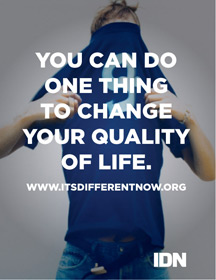
It’s Different Now was a social marketing campaign developed by the Vancouver STOP Project designed to change how the public perceived HIV and HIV testing. It also sought to prepare the general public for the integration of the routine offer of HIV testing in family practices and in hospitals. In doing so, this campaign aimed to decrease the stigma associated with HIV and HIV testing, and encourage people to say yes when offered a test by their healthcare provider.
Given that the target audience for the campaign was the general public and the goal was to raise awareness among this broad group, it was not designed to target specific high-risk populations, or to change the behaviours that might put specific populations at risk. Targeted social marketing campaigns for these populations were designed and delivered by community groups working with these populations.
The award-winning campaign used social and print media to disseminate its message. The campaign had two distinct phases: It’s Different Now (2011-2012) and Change HIVstory (2012-2013). The complementary phases of the campaign had the same two objectives. First, the campaign aimed to increase awareness about advances in HIV testing, treatment and prognosis, and reduce stigma around talking about the virus. Second, the campaign was designed to facilitate the discussion between healthcare providers and their patients about HIV testing as Vancouver began to integrate the offer of HIV testing into routine healthcare in hospital, family practices and other clinical settings the general public accesses.
In the second phase, which built on the messaging of the first, the Vancouver STOP Project added a call to action. This call to action encouraged people to seek an HIV test and tell their social networks to do the same in an effort to eradicate HIV.
Between 2011 and 2013, the It’s Different Now campaign also targeted healthcare providers in hospitals by using posters and branded merchandise in clinical settings. The goal of this aspect of the campaign was to remind clinicians how important the offer of an HIV test could be to the health of their patients.
Why Was the Program Developed?
This campaign was implemented to increase awareness of the contemporary realities of HIV and encourage people to take an HIV test. Specifically, the campaign was developed to support the routine offer of HIV testing initiatives integrated into many clinical settings in 2011. These settings included Vancouver’s four hospitals, many family practice settings and other clinical services. Integrating the routine offer of HIV testing in healthcare settings was a key activity of the Vancouver STOP Project, which aimed to significantly increase HIV testing and diagnosis in the city.
Staff of the Vancouver STOP Project knew that to encourage people to say yes to the HIV test when it was offered, people needed to understand the realities of HIV and HIV testing. Through consultations with healthcare providers they also learned that clinicians preferred the public be informed of the integration of a routine offer of HIV testing through a media campaign. They believed this would facilitate the discussion about HIV and HIV testing by updating people’s knowledge before they were offered a test.
How Does the Program Work?
The Vancouver STOP Project did not have the expertise to develop and deliver a social marketing campaign on the scale of It’s Different Now. Internal communications departments at both Providence Health Care and Vancouver Coastal Health, while skilled, are not structured to develop social marketing campaigns. The Vancouver STOP Project made a strategic decision to hire an outside marketing firm to develop the campaign.
Hiring a marketing firm
The Vancouver STOP Project contacted six firms through an Expression of Interest process to solicit proposals for the campaign. The Expression of Interest is available in the Program Materials section.
Four firms responded and were given the opportunity to present their strategy to the senior leadership of the Vancouver STOP Project. They chose False Creek Ventures, a firm that did not have much experience with health promotion campaigns, but that had submitted the most sophisticated idea and strategy for the campaign.
Developing the concept
Rationale
The purpose of the campaign was to normalize discussions of HIV, to facilitate the offer of an HIV test, to facilitate the acceptance of a test, and to reduce misconceptions and stigma about HIV. The Vancouver STOP Project wanted an edgy campaign to start a new conversation about HIV in Vancouver.
It’s Different Now
The central concept of the campaign is that HIV is different now. This idea grew out of discussions between False Creek Ventures and the Vancouver STOP Project. False Creek Ventures noticed that as the Vancouver STOP Project leadership spoke about HIV, HIV testing, treatment and prognosis, the underlying theme was that things had changed. The firm pitched “It’s Different Now” as the tagline and as the centrepiece of a strategy that would focus on four things about HIV that are different now: who should get tested, testing, treatment and prognosis.
Community Involvement
Once the campaign’s concept was developed, the Vancouver STOP Project ensured that the campaign was acceptable to community members living with HIV. They did this by meeting with community agencies that represent people living with HIV in Vancouver. Meetings were set up between False Creek Ventures, the Vancouver STOP Project and AIDS Vancouver, Positive Women’s Network, Positive Living BC and Health Initiative for Men to go over each campaign message and image.
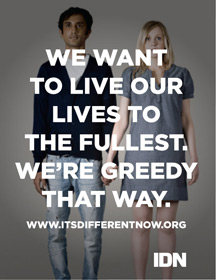
Campaign materials were reviewed line by line in person with each group. Community feedback centred on adjusting language to be more inclusive and less stigmatizing. The second phase of the campaign built on community feedback that suggested a campaign that highlighted the history of activism in Canada would be an effective way to disseminate a message about the importance of collective action. “Change HIVstory,” the theme of the second phase of the campaign, is a response to this feedback. This phase (described below) highlights the work of civil rights groups.
With the feedback from these consultations, False Creek Ventures and the Vancouver STOP Project tweaked messages and images.
Roll out
Phase 1: It’s Different Now

The first phase of the campaign was launched in November 2011. This phase included the launch of the website, promoted through print and Facebook advertising, and of social media feeds dedicated to the campaign. The goal of the print and Facebook ads, which were launched at the same time as a website and social media presence, was to pique the public’s interest and drive the audience to the It’s Different Now website. Ads ran for four weeks in 30 transit shelters, in community newspapers and free weeklies such as the Georgia Straight, and on Facebook. Some were purposefully vague, but designed to catch the audience’s attention.

Some of the original ads featured, among other images, a man in a mask with the tagline “It doesn’t matter who you are. We’re not judging, just testing.” Another featured a woman in a bunny hat with the tagline “We don’t think you’re special.” Please see the Program Materials section of this case study for all of the ads that ran in Vancouver during the campaign.
The Vancouver STOP Project believed that explicitly naming HIV in campaign materials targeted to the general public would reduce the effectiveness of the campaign, since the general public has traditionally perceived HIV to be someone else’s health problem. One of the goals of the campaign was changing this perception.
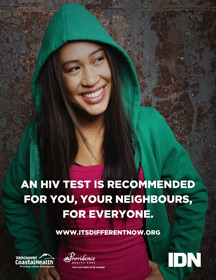
In addition to these ads, more explicit campaign ads that referred to HIV and HIV testing were also disseminated. The most prominent were a series of eight posters that featured a cross-section of people from Vancouver with the tagline “An HIV test is recommended for you, your neighbours, for everyone.”
The goal of all the ads was to drive traffic to the website where more detailed information about HIV was available. All print ads included a Quick Response (QR) code that allowed people with smartphones to access the website immediately. Both social and print media ads were disseminated to reach a cross-section of the population. Many older adults are not connected to social media and buying ad spaces in transit shelters and in community newspapers allowed the Vancouver STOP Project to reach a significant portion of the general public, regardless of their connectedness to social media.
Website
The strategy was to use the ads to drive people to the website. The site, which is no longer available in its original format, provided more information on the four things that have changed about HIV in the last few decades. These things are risk, testing, treatment and prognosis. The website also informed the public that HIV testing would now be routinely offered by family physicians and in hospitals.
In addition, the website featured two-minute videos by: Denise Becker, an HIV advocate and woman living with HIV; Dr. Réka Gustafson, Vancouver’s medical health officer; Dr. Mark Hull, an HIV primary care provider; Dr. Julio Montaner, director of the B.C. Centre for Excellence in HIV/AIDS; and Meaghan Thumath, an HIV specialist nurse. These videos describe how HIV testing, prognosis and treatment have improved over the last three decades and how people living with HIV today can live long and healthy lives, with relationships, careers and children. Each video ends by encouraging viewers to get tested or say yes to the test when it is offered.
Social media
A dedicated Facebook page and Twitter account were also established to allow people to continue the conversation started by the ad campaign. They also provided a space for the Vancouver STOP Project to disseminate the latest information about HIV that could not be done in print ads. In the winter of 2012, Facebook contests were used to increase the campaign’s reach by boosting the number of page “Likes.”
It’s Different Now in healthcare settings
Explicit ads that informed the public that an HIV test is recommended for everyone in Vancouver were also redeveloped into posters and displayed in four Vancouver-area hospitals, which introduced the routine offer of HIV testing about the same time the campaign was launched. While some of the ads featured the tagline from the wider campaign, a specific tagline (“An HIV test is recommended as part of all hospital care. Talk to your nurse or doctor.”) was developed specifically for patients in acute care. Ads in hospitals were translated into six of the most common languages spoken in Vancouver, to ensure the message was accessible to everyone seeking hospital care, regardless of their English proficiency.
These posters were made available to family physicians and other clinical services offering HIV testing to their patients and clients.
Phase 2: Change HIVstory
In the summer of 2012, the second phase of the campaign was launched. The second phase built on the success of the first and continued the public conversation about HIV.
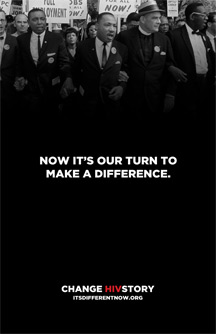
The campaign, referred to as Change HIVstory, centred on a call to action to all Vancouver residents to help eliminate HIV by getting tested. The primary vehicle for this message was a video available in various lengths. The video drew on the history of activism — about topics that included racial equality, the rights of Aboriginal peoples and women, gay marriage and the end of the Cold War — to consider the idea that, like with other movements, it might be possible to change HIV by working collectively. According to the video, “the best way to change history is when you becomes we.” This phase encouraged people not only to say yes to the test, but to get tested and then tell their friends about how HIV is different now.
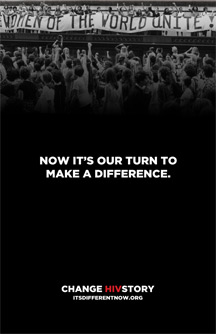
The videos from the second phase of the campaign were viewed far more often than the original series of videos, despite containing the same information. The emotional appeal of Change HIVstory appealed far more to the campaign’s audience than the traditional fact-based messaging of the first videos. The video was screened as a public service announcement on television and in movie theatres. It was also available on the It’s Different Now website.
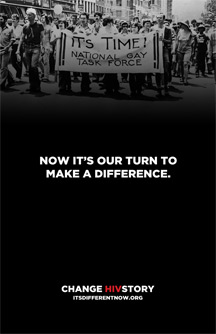
The campaign was promoted by outdoor print ads featuring the civil rights, women’s rights and gay rights movements. The tagline on these ads was “Now it’s our turn to make a difference.”
Reaching healthcare providers
In addition to reaching the public with information about HIV, the Vancouver STOP Project reached healthcare providers as well. Not all providers have a history of offering HIV testing and work was needed to encourage them to integrate the offer of HIV testing into their practice. In order to complement clinician education and training, the social marketing campaign included a component targeted to healthcare providers to facilitate the uptake of this change in practice.
The four hospitals that implemented routine HIV testing were papered with posters reminding doctors to offer an HIV test to patients. These posters complement those targeted to patients and feature a picture of each hospital’s medical leadership with the tagline “HIV testing should be offered to all your hospital patients. Don’t miss the diagnosis.”
Items branded with It’s Different Now were also distributed to family physicians and to healthcare providers in acute care and other settings. This included pens, lanyards, notebooks, screen savers and chocolate bars. Innovative and unexpected tactics were also used to promote HIV testing, which the Vancouver STOP Project were unsure would work. The delivery of 99 pies with pie plates bearing the It’s Different Now logo and a message about ending HIV was one such initiative.
Next Steps
As of January 2013, new phases of the campaign are not planned. Given that this campaign won awards and firmly established its brand in Vancouver, any future social marketing campaign would build on the strong work already done.
Although the STOP HIV/AIDS Project is slated to become a permanent program of the Government of British Columbia on April 1, 2013, and will be expanded to the rest of the province, no discussion about making the It’s Different Now campaign a provincial campaign has been undertaken.
Required Resources
Human resources
- Strong, collegial leadership team to oversee the development of the campaign’s messages and strategies.
- Enthusiastic and creative marketing firm able to incorporate feedback and provide sound guidance to develop the ideas and strategy for the campaign.
Material resources
- Campaign materials, including videos, posters, print advertising and branded merchandise for distribution.
- Social media such as Youtube, Twitter and Facebook.
Challenges
- Limited reach. The team worked with a modest budget, which limited its ability to buy advertising space and the duration of the campaign. The Vancouver STOP Project worked around this constraint by using the guidance that False Creek Ventures provided and leveraging that firm’s contacts to get free media time.
- Measuring impact. Although False Creek Ventures and the Vancouver STOP Project have been able to count the number of views, hits, “Likes” and tweets, it is impossible to measure the impact the campaign has had on testing numbers. Too many factors contribute to a person’s consenting to or asking for an HIV test.
Evaluation
False Creek Ventures has been tracking quantifiable metrics for the It’s Different Now campaign, including the number of hits on the website and the length of stay of viewers, the number of times the It’s Different Now and Change HIVstory videos have been viewed on the Internet, and the number of Facebook hits and tweets on Twitter. False Creek Ventures has also been able to track the number of times an It’s Different Now public service announcement has been played on television or in theatres and the projected number of people it reached.
Lessons Learned
- Strong marketing firm. False Creek Ventures, with its strong vision and clear strategy, was a significant facilitator to the development and launch of the campaign. This firm also brought creativity to the campaign, something Vancouver Coastal Health’s and Providence Health Care’s traditional communications departments, which do not focus their efforts on social marketing, were not as skilled at providing.
- Organizational representation on the campaign committee. In addition to the senior Vancouver STOP Project leadership team, representatives from the communications teams from Providence Health Care and Vancouver Coastal Health (which make up the Vancouver STOP Project) sat on the committee overseeing the It’s Different Now campaign. By having these representatives at the table, approval for campaign materials and messages from Providence Health Care and Vancouver Coastal Health happened quickly.
- Messaging. The engaging format of the Change HIVstory videos had far more views than the videos from the first phase, which provide the same content but appeal less to people’s emotions.
Program Materials
Contact Information
For more information, please contact
Scott Harrison
Director, Urban Health & HIV/AIDS
Providence Health Care
B552 1081 Burrard Street
Vancouver BC V6Z 1Y6
sharrison@providencehealth.bc.ca
What is the STOP HIV AIDS Project?
Seek and Treat for Optimal Prevention of HIV/AIDS (STOP) was a $48-million, four-year (2010-2013) pilot project funded by the government of British Columbia. This project aimed to increase the quality of life of people living with HIV and reduce the number of new HIV infections by taking a proactive public health approach to finding people living with HIV, linking them to HIV care and treatment programs, and supporting them to stay in care. STOP aimed to improve the experience of people living with HIV or AIDS in every health and social service interaction and significantly improve linkage and engagement across the full continuum of services in HIV prevention, testing and diagnosis, treatment, and care and support.
STOP was rolled out in Vancouver and Prince George. It was made up of numerous interconnected and discrete clinic-based, hospital-based, community-based and policy-focused programs implemented through the collaboration of a significant number of stakeholders. In Vancouver, Vancouver Coastal Health and Providence Health Care partnered to form the Vancouver Project. Through this partnership, these two organizations shared governance, funding and reporting for most of the initiatives that took place in Vancouver between 2011 and 2013.
With funds from the provincial STOP Project, the Vancouver STOP Project hired a marketing firm to develop a social marketing campaign to raise awareness in the general public about advances in HIV testing, treatment and prognosis and to encourage people to say yes to the test when they were offered one. This campaign was the public face of the Vancouver STOP Project — encouraging the general public to rethink what they think they know about HIV, reduce stigma and get people talking about HIV again.

